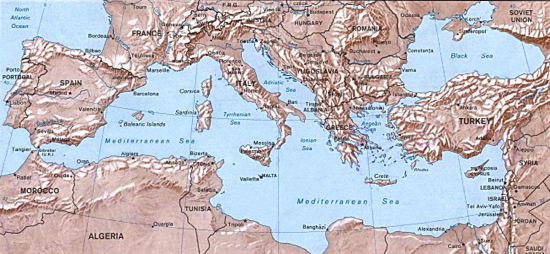Where does puff pastry come from?

I’d love to know the answer to that myself, reader Finn. The French claim to have invented puff pastry, but then don’t they stake a claim to everything with that much butterfat? The Italians also claim to have invented — or at least perfected — puff pastry, and indeed there are mentions of laminated dough that date back to Renniassance-era Venice and Florence. But then Spaniards and the Turks also maintain they were the first to perfect laminated dough, and at about the same time. So who’s right?
My own belief is that none of them are. Why? Because thinly-layered pastries have a long history in another (nearby) part of the world: the Middle East. Dough layering is said to go back to the Egyptians, only they used oil to lubricate their layers instead of butter (phyllo dough, for example, was originally lubricated with olive oil).
Leaving aside the French for a moment, what do Florence, Venice, Spain and Turkey all have in common? They all had extensive contact with the Middle East well before the rest of Europe. Spain was occupied by the Moors from about 700 A.D. to roughly 1500 A.D.. Florence and Venice were seafaring city-states that traded extensively with Arab peoples all through the Middle Ages and Rennaissance. As for Turkey, it was part of the Eastern Roman (Byzantine) Empire which bordered the Islamic Caliphate until Constantinople fell to the Ottomans in 1453 (at which point it became the defacto capital of the entire Middle East).
So…plenty of opportunity here for the societies of the Northern Mediterranean to pick up laminated dough-making techniques from the Arabs — which they then adapted to their local fats. All these peoples, especially the Turks, were big butter eaters. Anyway, makes sense to me! Thanks, Finn!
The earliest documentable recipe for something that is recognisably puff pastry is – as far as I know – actually in an English source. Hugh Plat’s “Delightes for Ladies”, published in 1602, contains a recipe for “Puff Past” which calls for making a plain pastry dough, rolling it out, covering it with butter, and doing several roll-and-fold iterations. Where he got the recipe from is unknown, but clearly it was known in western Europe by about 1600.
I’ve seen and eaten much earlier Mediterranean recipes that call for various forms of thin pastry layered with various things, including one for a “buttered, leafy pastry” that involves rolling the pastry out very thin, painting it with melted butter, then rolling it up “like a reed” and rolling it out again. It eventually gets cooked in a skillet and served up with honey, so it’s almost somewhere between puff pastry and baklava. That one comes from a 13th c. Andalusian cookbook. (And I should try making it again – it didn’t quite work out the first time; I think I didn’t use enough butter.)
Hey Jane!
There are some written references that predate that I think. Lancelot de Casteau, in a book dated 1550, talked about making puff pastry “in the Spanish style”, also there is a puff pastry item listed on the menu for Catherine de Méici’s coronation banquet “forty little plates of puff pastries”. That would have been dated 1547 I think. Some food historians believe that a 1311 French mention of gâteau feuillé referred to a puff pastry item (see Histoire de la vie privée de francois, volume 2).
I find that very easy to believe, myself. The Arabic technique of smearing oil or fat onto an extremely thin sheet of dough — which was then rolled up and flattened out and cut — was a very common thing in the courts of Renaissance Italy and Spain. This is probably what Lancelot was talking about when he said “in the Spanish style”. But I guess it all depends on what you mean by “laminated dough” or “puff pastry”. If it can only be folded then it’s probably French and relatively new. If it can be rolled then it’s not just Spanish or Italian or French, it’s actually Arabic and who knows how old it is? These are really fun things to think about, non?
Cheers and thanks for the excellent comment!
– Joe
The problem, of course, for us re-enactor cooks, is that references to something called “puff pastry” without description aren’t entirely helpful: the writer clearly knew what he meant, and assumed that his readers did, but words change meaning over time and location. Consider the various meanings of the word “pudding”, for example. The 1547 reference is *probably* close enough to Hugh Plat that it’s talking about the same thing, but by no means certainly.
In any case, I’ll have to track those references down – the evolution of baking and pastry is something of a hobby of mine. If I get really ambitious, it might make a good research paper for an A&S competition someday. Fun stuff, in any case 🙂
Oh believe me, I follow you, Jane. Clear written references and descriptions aren’t easy to come by in regard to food, even in the 20th century! It makes food history an especially speculative endeavor. And I enjoy it immensely!
Cheers and thanks for the comments!
– Joe